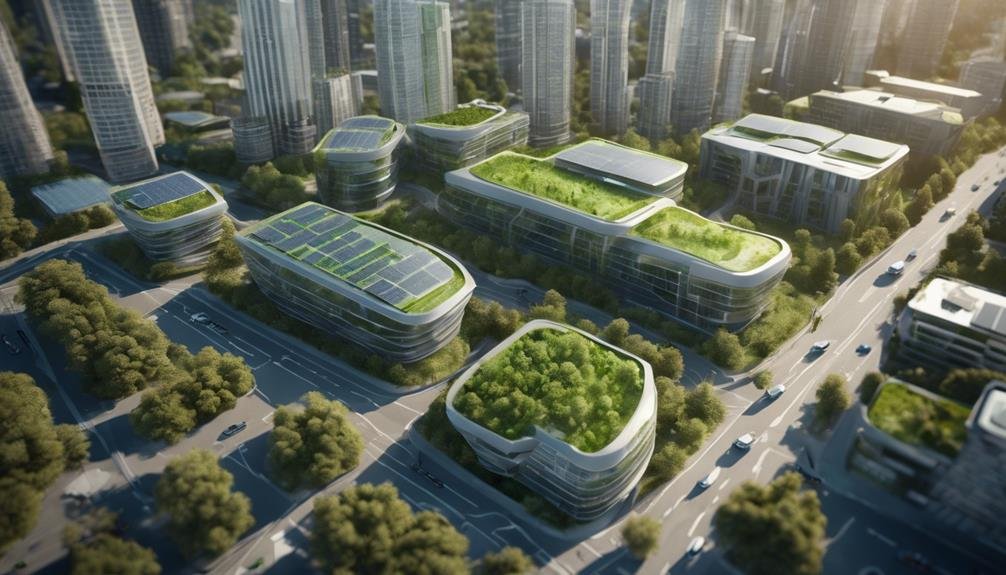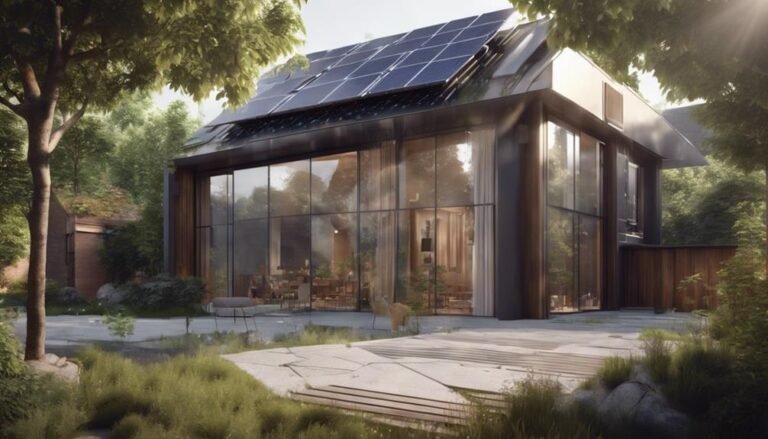Sustainable Urban Development: Planning for the Future
In the midst of rapid urbanization and increasing environmental concerns, the balancing act between progress and sustainability has never been more critical. As you navigate the complexities of urban development, understanding how to create cities that flourish while respecting the environment is paramount. By exploring innovative strategies and collaborative approaches, you can pave the way for a future where cities not only survive but thrive in the face of evolving challenges.
Key Takeaways
- Implement green infrastructure for energy efficiency and biodiversity.
- Embrace smart growth strategies to reduce sprawl and promote sustainability.
- Engage communities for inclusive urban planning and development.
- Invest in resilient infrastructure for climate change adaptation.
- Prioritize community preparedness through disaster planning and response.
The Importance of Sustainable Urban Development
Embracing sustainable urban development is essential in shaping a resilient and thriving future for communities worldwide. By integrating principles of a green economy and environmental stewardship into urban planning, cities can become hubs of innovation and sustainability.
A green economy focuses on sustainable practices that promote economic growth while reducing negative impacts on the environment. Through initiatives like renewable energy projects, green infrastructure, and sustainable transportation systems, cities can create jobs, improve public health, and mitigate climate change.
Environmental stewardship plays a pivotal role in ensuring that urban development is carried out responsibly, with a focus on preserving natural resources and protecting ecosystems. By prioritizing green spaces, implementing waste reduction strategies, and promoting biodiversity within urban areas, cities can enhance the quality of life for residents while safeguarding the planet for future generations.
Incorporating these concepts into urban planning not only benefits the environment but also fosters a more resilient and prosperous future for all. By embracing sustainable practices, cities can pave the way for a more sustainable and equitable world.
Key Principles for Urban Planning
To shape urban environments that thrive sustainably, urban planning must embody key principles that drive innovation and resilience in city development. When focusing on urban design, it's vital to prioritize mixed land use, compact building design, and accessible public spaces.
By blending residential, commercial, and recreational areas, cities become more vibrant and reduce the need for extensive transportation networks, leading to a more sustainable lifestyle.
In considering environmental impact, the principles of green infrastructure, energy efficiency, and waste management play a pivotal role. Implementing green roofs, permeable pavements, and urban forests can mitigate the urban heat island effect and enhance biodiversity.
Energy-efficient buildings, renewable energy sources, and smart grids contribute to reducing carbon emissions. Additionally, effective waste management systems encompassing recycling, composting, and waste-to-energy facilities help minimize landfill waste and promote a circular economy mindset.
Integrating Green Infrastructure
Harnessing the power of green infrastructure is pivotal to creating sustainable urban environments that harmonize with nature while promoting community well-being and ecological balance. By integrating elements like green roofs and permeable pavements into urban planning, cities can mitigate the impact of development on the environment while enhancing quality of life for residents.
Consider the following table that highlights the benefits and features of green roofs and permeable pavements:
| Green Roofs | Permeable Pavements |
|---|---|
| – Reduce urban heat island effect | – Reduce stormwater runoff |
| – Improve air quality | – Recharge groundwater |
| – Provide habitat for wildlife | – Filter pollutants |
| – Enhance building energy efficiency | – Prevent flooding |
Green roofs not only beautify the urban landscape but also help in reducing energy consumption and improving air quality. On the other hand, permeable pavements play a critical role in managing stormwater and preventing flooding, contributing to a more resilient urban infrastructure. By incorporating these green infrastructure elements, cities can move towards a more sustainable and environmentally friendly future.
Smart Growth Strategies
By implementing smart growth strategies, urban planners can strategically shape the future development of cities to prioritize sustainability and efficient land use. Embracing urban density and promoting efficient transportation systems are key components of smart growth strategies.
Here's how you can enhance urban development through smart growth approaches:
- Urban Density: Encourage higher urban density to reduce sprawl, preserve green spaces, and support a sense of community. Compact, mixed-use developments promote a vibrant urban environment while utilizing land more efficiently.
- Mixed-Use Development: Foster mixed-use developments that blend residential, commercial, and recreational spaces. This approach enhances walkability, reduces the need for long commutes, and creates dynamic neighborhoods where people can live, work, and play in proximity.
- Walkability: Design pedestrian-friendly environments with ample sidewalks, green spaces, and amenities within walking distance. Prioritizing walkability not only promotes physical activity and healthier lifestyles but also reduces reliance on cars, easing traffic congestion and lowering carbon emissions.
Community Engagement and Participation
You need to harness the power of active community involvement to drive sustainable urban development forward.
By fostering meaningful public consultations, you can guarantee that the voices of all stakeholders are heard and considered in the decision-making process.
Embracing community engagement and participation is key to creating inclusive, resilient cities that thrive on collaboration and shared vision.
Active Community Involvement
To foster sustainable urban development, active community involvement through robust engagement and participation is paramount. Citizens are the heart of a community, and their input is invaluable in shaping the future.
Here's how you can make a difference:
- Engage in Public Workshops: Attend and actively participate in public workshops where ideas are shared, and decisions are made collectively. Your voice matters, and your ideas can contribute significantly to the development process.
- Empower Your Community: Take the lead in empowering your community by encouraging others to get involved. Organize events, workshops, or initiatives that promote collaboration and unity within the neighborhood. Strong communities are built on the foundation of empowered individuals.
- Collaborate through Stakeholder Engagement: Engage with various stakeholders, including local authorities, businesses, and nonprofit organizations. By collaborating with different entities, you can create a network of support and resources that will drive sustainable urban development forward.
Meaningful Public Consultations
Meaningful public consultations serve as the cornerstone of community engagement and participation in sustainable urban development, fostering a collaborative environment where diverse voices shape the direction of progress. By actively seeking community feedback and encouraging stakeholder engagement, cities can secure that their development plans align with the needs and aspirations of their residents.
Engaging the public in a meaningful way goes beyond just gathering input; it involves creating opportunities for dialogue, listening with empathy, and incorporating suggestions into decision-making processes. When cities prioritize inclusive consultations, they not only build trust with their communities but also tap into a wealth of local knowledge that can lead to more innovative and sustainable solutions.
Stakeholder engagement in urban planning isn't a one-time event but an ongoing commitment to transparency and openness. By involving residents, businesses, and other key players in the decision-making process, cities can create a sense of ownership and shared responsibility for the future development of their urban landscapes.
Embracing meaningful public consultations isn't just a best practice; it's a strategic imperative for building resilient and thriving cities.
Building Resilient Cities
You know the key to sustainable urban development lies in building resilient cities.
Embracing resilience in infrastructure and fostering community preparedness are critical components.
Resilience in Infrastructure
By integrating resilient infrastructure systems, cities can effectively withstand and recover from various environmental, social, and economic challenges, ensuring sustainable urban development.
When focusing on resilience in infrastructure, consider the following key aspects:
- Infrastructure Adaptation to Climate Change: Implementing infrastructure that can adapt to the impacts of climate change is vital. This includes designing buildings, roads, and utilities that can withstand extreme weather events and rising sea levels.
- Resilient Design for Disaster Planning: Incorporating resilient design principles into infrastructure projects is essential for effective disaster planning. This involves creating structures and systems that can bounce back quickly after a disaster, reducing downtime and ensuring continuity of essential services.
- Investing in Smart Technologies: Utilizing smart technologies such as sensors, data analytics, and automation can enhance the resilience of infrastructure. These technologies can help cities monitor infrastructure health in real-time, predict potential failures, and facilitate rapid responses in case of emergencies.
Community Preparedness
Integrating community preparedness measures is a proactive approach towards building resilient cities that can effectively withstand and recover from various challenges, promoting sustainable urban development. In the face of increasing natural disasters and unforeseen emergencies, disaster readiness plays a critical role in fostering community resilience.
By empowering residents to be actively involved in emergency response planning and preparedness activities, cities can enhance their ability to mitigate risks and bounce back stronger in times of crisis.
Community preparedness involves creating robust communication networks, establishing evacuation plans, and conducting regular drills to guarantee swift and coordinated responses in emergencies. Engaging with local stakeholders, including businesses, schools, and community organizations, is key to building a cohesive network that can effectively mobilize resources and support during times of need.
Conclusion
To sum up, as you plan for the future of cities, remember this: 'A stitch in time saves nine.'
By embracing sustainable urban development principles, integrating green infrastructure, and fostering community engagement, you're laying the groundwork for resilient, vibrant, and environmentally conscious cities that will thrive for generations to come.
Keep pushing boundaries, thinking innovatively, and working towards a future where cities aren't just sustainable, but truly thriving.
The time to act is now, and the future is in your hands.





